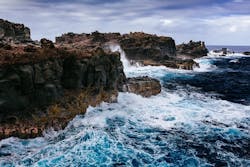NOAA Study Finds Rising Cliff Erosion
A report released by the San Diego’s Scripps Institution of Oceanography and funded by the National Oceanic and Atmospheric Administration’s (NOAA) California Sea Grant program found that historical data to predict coastal cliff erosion and sea-level rise may be unreliable moving forward.
The report investigated major cliff failures from 1998 to 2010 finding coastal bluff erosion rates of 12 ft per year. The study’s author, Adam Young, found vast discrepancies between these recent findings and historical trends. Young utilized light detection and ranging technology (LIDAR) to develop three dimensional images of the the California coastline.
The study reiterated a recent U.S. Geological Survey report that predicted rising tides over up to 67% of Southern California beaches by 2100. Young asserts the scientific community will continue to research and develop more accurate predictions.
“Ultimately, we’d love to make prediction. We’re getting more and more data as we move forward, and the data is getting much better. We’ll start to understand these things in the future for sure,” Young said regarding the future.


